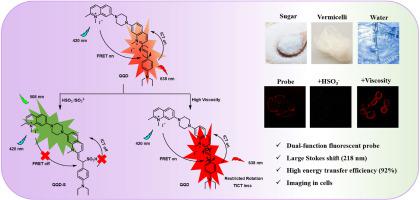当前位置:
X-MOL 学术
›
Anal. Chim. Acta
›
论文详情
Our official English website, www.x-mol.net, welcomes your
feedback! (Note: you will need to create a separate account there.)
A highly sensitive ratiometric fluorescent probe for detecting HSO3−/SO32− and viscosity change based on FRET/TICT mechanism
Analytica Chimica Acta ( IF 5.7 ) Pub Date : 2024-04-09 , DOI: 10.1016/j.aca.2024.342588
Feng-Ting Liu 1 , Shu-Mei Zhai 1 , Dong-Fang Gao 2 , Shu-Hao Yang 1 , Bao-Xiang Zhao 1 , Zhao-Min Lin 2
Analytica Chimica Acta ( IF 5.7 ) Pub Date : 2024-04-09 , DOI: 10.1016/j.aca.2024.342588
Feng-Ting Liu 1 , Shu-Mei Zhai 1 , Dong-Fang Gao 2 , Shu-Hao Yang 1 , Bao-Xiang Zhao 1 , Zhao-Min Lin 2
Affiliation

|
Sulfur dioxide (SO) is a significant gas signaling molecule in organisms, and viscosity is a crucial parameter of the cellular microenvironment. They are both involved in regulating many physiological processes in the human body. However, abnormalities in SO and viscosity levels are associated with various diseases, such as cardiovascular disease, lung cancer, respiratory diseases, neurological disorders, diabetes and Alzheimer's disease. Hence, it is essential to explore novel and efficient fluorescent probes for simultaneously monitoring SO and viscosity in organisms. We selected quinolinium salt with good stability, high fluorescence intensity, good solubility and low cytotoxicity as the fluorophore and developed a highly sensitive ratiometric probe to identify SO and viscosity changes based on Förster resonance energy transfer/twisted intramolecular charge transfer (FRET/TICT) mechanism. Excitingly, compared with other probes for SO detection, not only identified HSO/SO with a large Stokes shift (218 nm), low detection limit (1.87 μM), good selectivity, high energy transfer efficiency (92 %) and wide recognition range (1.87–200 μM), but also identified viscosity with a 26-fold fluorescence enhancement and good linearity. Crucially, was applied to detect HSO/SO and viscosity in actual water and food samples. In addition, had low toxicity and good photostability for imaging HSO/SO and viscosity in cells. These results confirmed the feasibility and reliability of for HSO/SO and viscosity imaging and environmental detection. We reported a unique ratiometric probe for detecting HSO/SO and viscosity based on the quinolinium skeleton. In addition to detecting HSO/SO and viscosity change in actual water and food samples, could also monitor the variations of HSO/SO and viscosity in cells, which provided an experimental basis for further exploration of the role of SO derivatives and viscosity in biological systems.
中文翻译:

基于 FRET/TICT 机制的高灵敏度比率荧光探针,用于检测 HSO3−/SO32− 和粘度变化
二氧化硫(SO)是生物体中重要的气体信号分子,粘度是细胞微环境的关键参数。它们都参与调节人体的许多生理过程。然而,SO和粘度水平的异常与多种疾病有关,如心血管疾病、肺癌、呼吸系统疾病、神经系统疾病、糖尿病和阿尔茨海默病。因此,有必要探索新型高效的荧光探针来同时监测生物体中的 SO 和粘度。我们选择稳定性好、荧光强度高、溶解性好、细胞毒性低的喹啉盐作为荧光基团,基于福斯特共振能量转移/扭曲分子内电荷转移(FRET/TICT)机制,开发了高灵敏度比率探针来识别SO和粘度变化。 。令人兴奋的是,与其他用于SO检测的探针相比,不仅识别的HSO/SO具有大斯托克斯位移(218 nm)、低检测限(1.87 μM)、良好的选择性、高能量转移效率(92%)和宽识别范围( 1.87–200 μM),而且还发现粘度具有 26 倍的荧光增强和良好的线性。至关重要的是,用于检测实际水和食品样品中的 HSO/SO 和粘度。此外,其毒性低,对 HSO/SO 成像和细胞粘度具有良好的光稳定性。这些结果证实了HSO/SO和粘度成像以及环境检测的可行性和可靠性。我们报道了一种基于喹啉骨架的独特比率探针,用于检测 HSO/SO 和粘度。 除了检测实际水和食品样品中的HSO/SO和粘度变化外,还可以监测细胞内HSO/SO和粘度的变化,为进一步探索SO衍生物和粘度在生物系统中的作用提供实验基础。
更新日期:2024-04-09
中文翻译:

基于 FRET/TICT 机制的高灵敏度比率荧光探针,用于检测 HSO3−/SO32− 和粘度变化
二氧化硫(SO)是生物体中重要的气体信号分子,粘度是细胞微环境的关键参数。它们都参与调节人体的许多生理过程。然而,SO和粘度水平的异常与多种疾病有关,如心血管疾病、肺癌、呼吸系统疾病、神经系统疾病、糖尿病和阿尔茨海默病。因此,有必要探索新型高效的荧光探针来同时监测生物体中的 SO 和粘度。我们选择稳定性好、荧光强度高、溶解性好、细胞毒性低的喹啉盐作为荧光基团,基于福斯特共振能量转移/扭曲分子内电荷转移(FRET/TICT)机制,开发了高灵敏度比率探针来识别SO和粘度变化。 。令人兴奋的是,与其他用于SO检测的探针相比,不仅识别的HSO/SO具有大斯托克斯位移(218 nm)、低检测限(1.87 μM)、良好的选择性、高能量转移效率(92%)和宽识别范围( 1.87–200 μM),而且还发现粘度具有 26 倍的荧光增强和良好的线性。至关重要的是,用于检测实际水和食品样品中的 HSO/SO 和粘度。此外,其毒性低,对 HSO/SO 成像和细胞粘度具有良好的光稳定性。这些结果证实了HSO/SO和粘度成像以及环境检测的可行性和可靠性。我们报道了一种基于喹啉骨架的独特比率探针,用于检测 HSO/SO 和粘度。 除了检测实际水和食品样品中的HSO/SO和粘度变化外,还可以监测细胞内HSO/SO和粘度的变化,为进一步探索SO衍生物和粘度在生物系统中的作用提供实验基础。


































 京公网安备 11010802027423号
京公网安备 11010802027423号